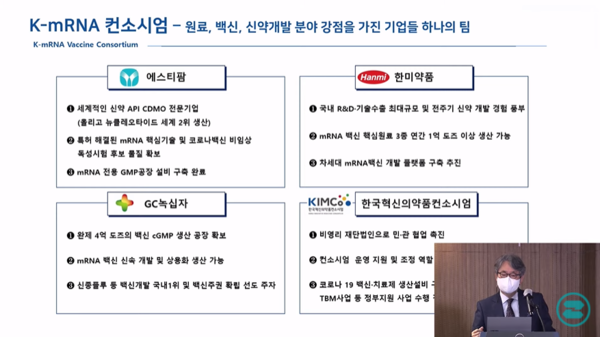A consortium of Korean companies to develop and manufacture a Korean-made messenger RNA vaccine against Covid-19 officially launched Tuesday. However, industry watchers raised questions about the detailed roles of the participating companies.
The Ministry of Health and Welfare and the Korea Pharmaceutical and Bio-Pharma Manufacturers Association (KPBMA) announced the launch of the K-mRNA vaccine consortium on Tuesday.
The consortium is led by three pharmaceutical firms – Hanmi Pharmaceutical, ST Pharm, and GC Pharma – and is supported by the Korea Innovative Medicines Consortium (KIMCo).
The consortium aims to produce 100 million doses of mRNA vaccine by next year and establish a massive production system based on mRNA platform by 2023 to export mRNA vaccine.
The three companies and KIMCo said they would spend over 700 billion won on conducting clinical trials, securing key ingredients, and building mass-production facilities.

Under the consortium, the three companies will help Korea secure “mRNA vaccine sovereignty” but grab an opportunity to enter a new attractive market.
According to “mRNA Vaccines-Global Market Trajectory & Analytics” published by Global Industry Analysts (GIA), the global mRNA vaccine market is expected to grow from $64 billion in 2021 to $127 billion in 2027 at an annual growth rate of 11.9 percent.
Moderna, which developed an mRNA vaccine, posted $1.93 billion in sales in the first quarter, 250 times $8 million recorded in the same period of last year.
This year, the company is expected to earn $19.2 billion from vaccine sales.
Pfizer is also anticipating a spike in revenue thanks to the development of an mRNA vaccine. The company earned $154 million solely from selling the Covid-19 vaccine in the fourth quarter of last year. Pfizer’s annual revenue from the Covid-19 vaccine is expected to reach $26 billion.
KPBMA forecast that Korean companies’ securing 10-20 percent of the global mRNA vaccine market would lead to $6.4 billion-$12.8 billion revenue.
However, some observers have raised doubts about whether the consortium would successfully develop an mRNA vaccine because the government and the consortium did not present detailed plans about each company’s role and investment proportions.
The three companies under the consortium did not announce their plans. However, they all spoke in one voice that they would not develop a candidate substance or a platform technology related to mRNA vaccine separately from the consortium. They vowed to invest all their technologies and manufacturing capabilities to develop the mRNA vaccine under the consortium successfully.
ST Pharm has licensed in a lipid nanoparticle (LNP) drug delivery technology, a key to developing an mRNA vaccine, from Genevant Science. The company recently announced that it secured three Covid-19 mRNA vaccine candidates without any patent problem.
Hanmi said it could produce and refine 120 million doses of undiluted solutions of mRNA vaccine at its plant in Pyeongtaek, Gyeonggi Province.
GC Pharma has a factory in Ochang, North Chungcheong Province, capable of mass-production of finished drugs. The factory can manufacture 400 million doses annually, and the number could go up to 1 billion doses with additional production lines, GC Pharma said.
The consortium could prompt the company’s plant in Hwasun, South Jeolla Province, to produce undiluted solutions of mRNA vaccine, officials of GC Pharma said.
A pharmaceutical industry source said Hanmi could handle the production of plasmid DNA, the raw material and enzymes, ST Pharm, raw material production and LNP technology utilization, and GC Pharma, manufacturing of drug products (DP).
However, another pharmaceutical official said the consortium did not seem to have discussed the exact roles of each company.
“At the launching ceremony, the roles of each company were explained somewhat vaguely. Their roles could not have been divided clearly as the consortium has just started,” the official said.

